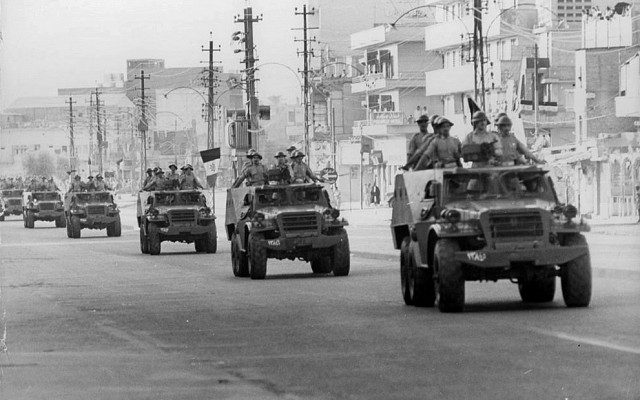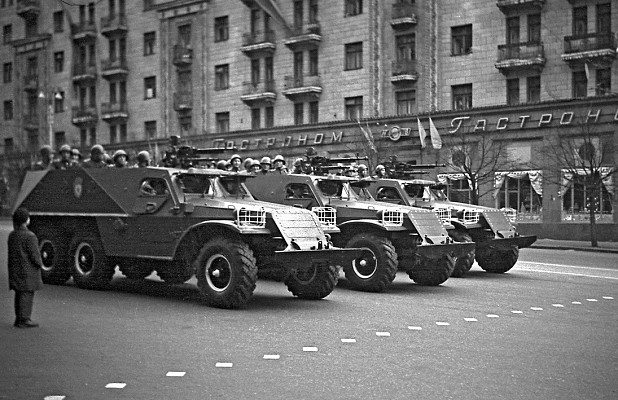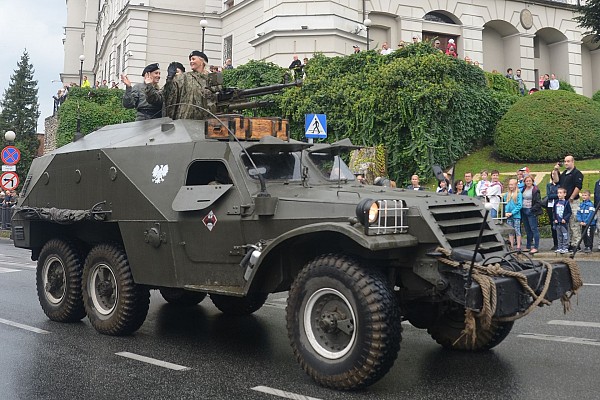BTR-152
Overview

BTR-152V
Soviet BTR-152V armored personnel carrier based on the ZiL-157 truck chassis, fitted with winch and external tire pressure system.
Source: www.btvt.info -
© Copyright lies with original owner
(renamed ZiL in 1956)
Soviet Union - BAZ - Bryansk Auto Zavod
1960 - 1962
4.923 BTR-152
2.904 BTR-152V
611 BTR-152V1
Type 56
Object 140 / BTR-140 (prototype)
Description
Introduction
The BTR-152 is an early Cold War era armored personnel carrier of Soviet origin. The Soviet army was lacking an armored personnel carrier available in large numbers during World War 2. Both the Nazi German Sd.Kfz 251 and American M3 half-track were used by Soviet forces during World War 2. After the war both half-track and wheeled prototypes were tested, with the latter being more economical to produce and requiring less maintenance.
Design
The BTR-152 is based on the ZiS-151 truck chassis. A monocoque armored hull is placed on the chassis, which has a large open rear troop compartment. Armament could be fitted on one or more pintle mounts. With tire pressure having major impact on off road performance various types of tire pressure regulation systems were used, both external and internal systems. Production later switched to the ZiL-157 truck chassis. At the end of the production lifecycle the closed roof BTR-152K was introduced with the nuclear battlefield in mind.
Firepower
The main armament of the BTR-152 is the 7.62mm SGMB machine gun. This is a heavier weapon than a general purpose machine gun and capable of sustained fire. Some vehicles were fitted with a 12.7mm DShKM heavy machine gun, although this was rather uncommon. Dedicated anti-aircraft vehicles were fitted with a large ZTPU-2 ring mount with two 14.5mm KPV heavy machine guns.
Protection
The steel armor protects against small arms fire and shell splinters. Over the frontal arc the armor is well sloped, but the sides of the troop compartment are vertical. The large open roof is a major hazard to small arms fired, proximity fused artillery shells and NBC threats. The tires are vulnerable to damage as well. The BTR-152K and command post vehicles feature an enclosed armored roof and have NBC filtration systems.
Mobility
The mobility of the BTR-152 on roads is very good. The 6x6 chassis provides reasonable all terrain performance. The BTR-152 has always been quite heavy for its chassis on soft soil. Tire pressure can be regulated for better off road performance. Compared to Soviet and German WW2 era half-tracks the BTR-152 requires far less maintenance and is more reliable. Maximum speed on road is 65 km/h.
Users
The BTR-152 was acquired in large numbers by Soviet forces. Many were exported to allies of the USSR as the BTR-60 became available in quantity for domestic use. East Germany acquired over 750 vehicles. Poland used over 400 and Egypt used about 1.000 vehicles in various conflicts with Israel. Small numbers of BTR-152 remain in service in Asia, South America and Africa, mostly in a reserve role.
Variants

BTR-152
Soviet BTR-152 armored personnel carrier based on the original ZiS-151 truck chassis with narrow wheels and without winch.
Source: www.btvt.info -
© Copyright lies with original owner
List of BTR-152 production variants
Details
Media
Subcomponents

7.62mm SGMB machine gun
The 7.62mm SGMB flexible machine gun is commonly found on the BTR-152. Up to three of these machine guns can be fitted, although normally only one is present.

12.7mm DShKM heavy machine gun
Some BTR-152 used a single 12.7mm DShKM heavy machine gun as main armament.
Related articles

BTR-40
The BTR-152 was designed to supplement and replace the BTR-40 as armored personnel carrier. The BTR-152 is larger and can carry more infantry.

BTR-152A
The BTR-152A is a self-propelled anti-aircraft gun armed with two 14.5mm KPV heavy machine guns. It is based on the chassis of the BTR-152 armored personnel carrier, while the BTR-152E is based on the improved BTR-152V.























